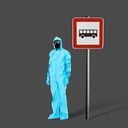The coronavirus is sending public transit into a death spiral

Published Date: 4/8/2020
Source: axios.com
Public transit systems across the country are experiencing a painful trifecta: Ridership has collapsed, funding streams are squeezed, and mass transit won't bounce back from the pandemic nearly as fast as other modes of transportation.Why it matters: Transit agencies could see an annual shortfall of as much as $38 billion due to the coronavirus pandemic, according to TransitCenter. At the same time, they're more important than ever, with more than 36% of essential workers relying on public transportation to get to work. "There's never been a time in which transit in one fell swoop has taken such a hit," said Sam Schwartz, CEO of Sam Schwartz Engineering and former New York City traffic commissioner.Between the lines: Most public transit systems are operating at only 10% capacity — with skeletal schedules with minimal crews — to transport essential workers to their jobs at hospitals, medical centers, pharmacies and grocery stores, per Paul Skoutelas, CEO of the American Public Transportation Association.But even with drastic drops in ridership, busier systems are still struggling with sporadic crowding and workers have fallen ill — increasing the risk that the transit systems themselves could contribute to the spread of the virus.New York's MTA has had more than 1,100 employees test positive for COVID-19, while 5,600 have been quarantined — and 33 have died, New York City Transit Interim President Sarah Feinberg told NY1 on Monday. In Los Angeles, some bus drivers are worried for their safety and want the system to close, per the local CBS affiliate.The catch: Skoutelas noted that virtually all systems still have an obligation to provide door-to-door transportation to elderly and disabled passengers who still have urgent health care needs.When asked if systems would shut down completely to protect both workers and passengers, Skoutelas said those decisions would be made on a case-by-case basis at a local level.What's happening: Public transit systems have taken extra steps to keep their remaining passengers — and workers — safe during the epidemic. In Seattle, King County Metro and Sound Transit stopped collecting fares last month and instructed riders to board buses through the back door to maintain distance from drivers. In New York City, MTA may have to shift funds earmarked for capital plans to its operating budget to float the system, which could lose $6 billion in a year if ridership stays this low. It's sanitizing stations and common touch points (like turnstiles) twice a day and disinfecting the entire fleet every 72 hours.In San Francisco, transit services have been drastically scaled back. BART, which saw a 90% drop in ridership since the coronavirus outbreak hit the city, is reducing hours. The city's busy subway and light rail system, Muni Metro, has been shut down indefinitely, and all bus lines except the 17 busiest have been closed, per the San Francisco Chronicle.In Houston, Metropolitan Transit Authority has installed netting in the middle of hundreds of buses to create more separation between drivers and passengers, who will sit in the back, per the Houston Chronicle. Metro has suspended fares and is taking drivers' temperatures at the beginning of shifts. In Boston, the MBTA added five commuter rail trains to better accommodate health care workers' and emergency responders shifts. The agency is providing personal protective equipment. 30 employees have tested positive for coronavirus, and one inspector has died from COVID-19, per the Boston Globe.In Pittsburgh, the Port Authority staggered shifts to reduce the number of workers in the depot at any time. In the short term, transit experts expect the $2 trillion stimulus package — which allocated $25 billion for public transit agencies — to help agencies maintain minimal levels of service for essential workers. In the long term, many expect to need additional funding from the next relief installment passed by Congress. President Trump and House Speaker Nancy Pelosi have signaled the desire to allocate money for infrastructure."The financial fallout from the loss of fare revenue and loss of state and local taxes will last a couple of years. It will be an ongoing challenge to fill those gaps," said Ben Fried, TransitCenter's communications director.It may take much longer. After the 9/11 terrorist attack in New York City, it took the subway nearly six years to fully recoup ridership, according to Schwartz, the former New York City traffic commissioner. With the contagious nature of COVID-19, passengers will be hesitant to sit shoulder-to-shoulder on a subway car or in a crowded bus for what could be a substantial period of time, even after people gradually return to work. People will likely rely more on personal cars, or even personally owned bikes and scooters that are not shared, said David Zipper, visiting fellow at the Harvard Kennedy School's Taubman Center for State and Local Government.What to watch: Congestion pricing schemes — in which cars are charged for entering certain parts of the city and some proceeds go to public transportation needs — could help fill some funding gaps for transit, Schwartz said.